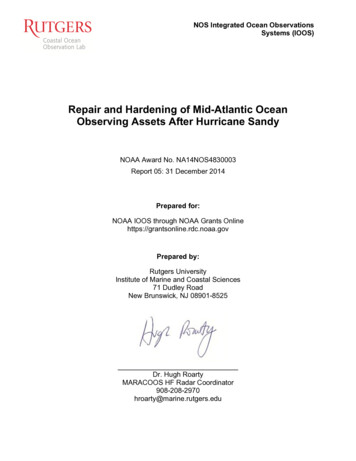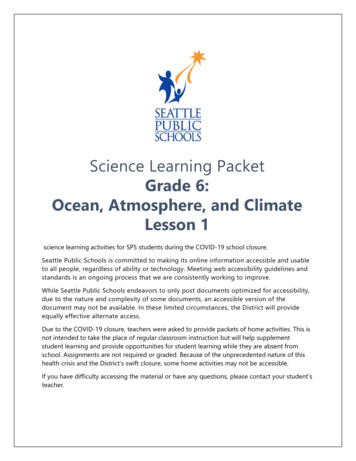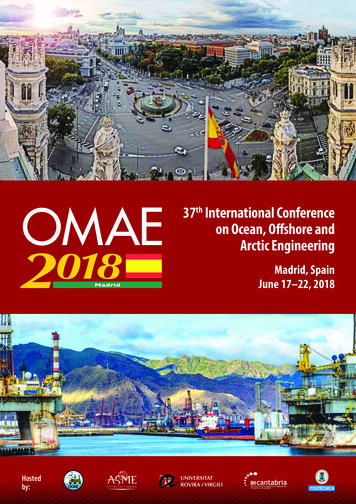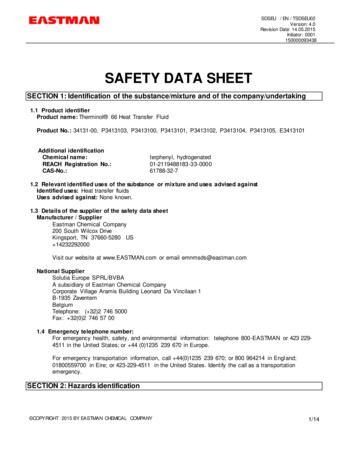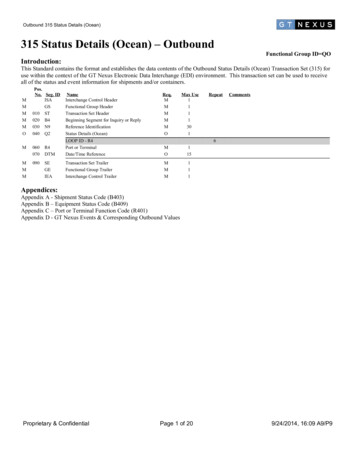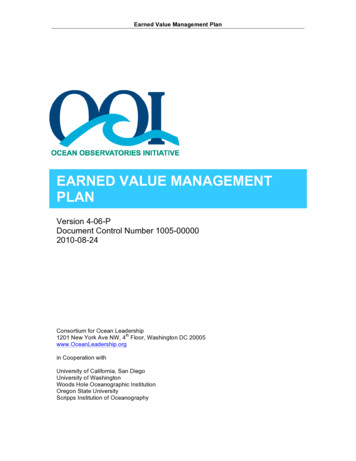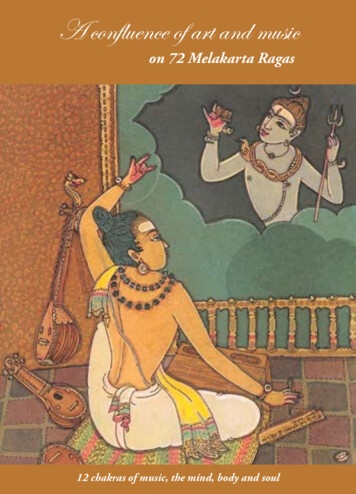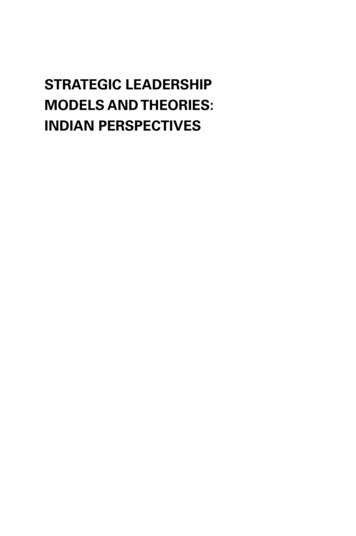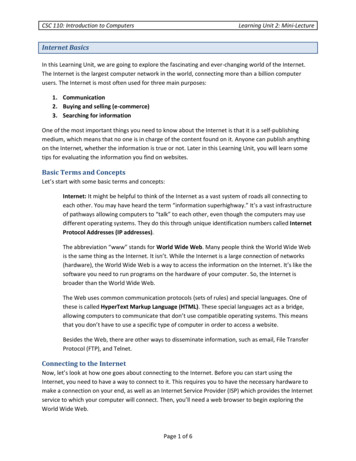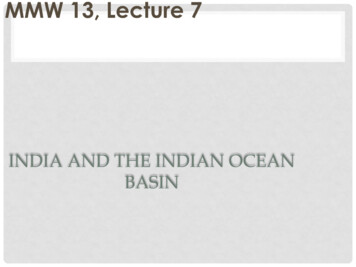
Transcription
INDIA AND THE INDIAN OCEANBASIN
WHAT WE TALKED ABOUT LAST WEEK West Africa: State and society Western Europe: State and society Today:1) Continue on Europe2) India and the Indian Ocean Basin3) The Song Modernity in East Asia
(WESTERN) EUROPE Marginal and yet dynamic (thanks to contingentfactors and southernization)
UNIVERSITY:CITY AND THE CHURCH Increasing urbanization led to demand for trained clergy Church promoted it as a way to expand clerical authority, ecclesiasticalhierarch and Consolidate the “canon law”. Scholastic guild (or guilds)
CATHEDRAL AND MONASTIC SCHOOLS
BOLOGNA UNIVERSITY
SCIENTIFIC METHOD A New Method of knowledge: Aristotle1) Logic: Use of philosophy for the understanding ofreality.2) Philological Analysis: To study the words analytically. Medicine: Ibn-Sina or AvicennaIslamic philosophers. Translation of Greek texts (from Arabic): Aristotle’stexts.
AVERROES (1126-1198)NO CONFLICT BETWEEN FAITH AND REASON
PREMISE (PROTASIS) AND CONCLUSION
RISE OF SCHOLASTICISM Proto-Empirical Studies William of Ockham (1288 - c. 1348) Franciscan FriarParismony: motion is not a distinct thing but is only themoving object.Nominalism: Abstracts do not exist, only product ofhuman mind.Also Conceptualism.
PLATO’S CAVE
Who said this?
“Nature gives speech to human beings, andspeech is directed to human beingscommunicating with one another regarding theuseful and harmful, the just and the unjust, the like.Therefore, since nature does nothing in vain, humanbeings by nature communicate with one anotherabout these things. But communication about thesethings produces the household and the politicalcommunity. Therefore, human beings are by naturedomestic and political animals.”
THOMAS AQUINAS(1225-1274)
PRE-ENLIGHTENMENT RATIONALISM? Saw theology as a science. Faith and Reason: Humans have the rationalability to know the divine without its help. Nature and action: a way of understandingGod
READ “POLITICALCOMMUNITY”--Through reason, a distinct human function, we canachieve virtue.--State exists to protect the human good.--Natural law: doing good and avoiding evil; all,including rulers, should follow this.
FAMILY Rule over wife is political Kingly rule over children “For the household manager strives about humanbeings more than the acquisition of inanimatethings And he should strive for the virtue by whichhuman beings live well more than the virtue bywhich one acquires and increases property well,which is the meaning of the word wealth.” p 71.
RISE OF FAMILY
CITY AND LOVE
LOVE
“COURTLY LOVE” Love as a cultural construct. In late Medieval period love is gradually becoming“civilized”. Aristocracy cultivates its emotions and sensitivity andconsiders self-control as a privileged way to represssexuality and make love a pure act of “romance”. Erotic love as spiritual transcendence
CURSING AND THE BODY
SOCIAL DIMENSIONS Class: A way to distinguish Class:Chivalrous expression. Society-Church: against ecclesiastical sexual attitudes,which saw sex as procreation (heretical). Literary expressionsvernacularism: English, French, German, Italian
GEOFFREY CHAUCER1343 – 1400 Vernacular English Translated Frenchchivalric poems into MiddleEnglish The Canterbury Tales
DANTE ALIGHIERI (1265-1321) &BEATRICE PORTINARI (1266-1290) La Vita Nuova(1294)La Commedia(1321)
ROMEO & JULIET
VERONA
LOVE AND FAMILY IN ASIA Shakuntala, c. 400. romantic love Shirin and KhusruNizam Ghanjavi (1141–1209)
Zho Daguan in Angkor (1297)
AXIAL AGE AND SOUTHERNIZATION A major transformation in human thinking (600-250B.C.E.), laid the grounds for core cultural and religiousdiscourses and practices of classical societies: Greece,Israel, Persia, India, and China. Buddha, Confucius and Socrates(near-contemporaries). Jainism and Buddhism: emerged out of the religiousferment of the Axial Age. So did Islam!
INDIACULTURE & RELIGION2) Spread of Hinduism(within India) andBuddhism (east Asia)3) Helped introduce Islam to southeast Asia.4) Vast Zones of Communication: commerce andinterexchange between people around sea routesand ports.
A COLLAGE Collage of microcultures, cultures that had theirown autonomy and yet intermingled with others.
OUR FOCUS1)Politics2)Economy3)Culture and Religion
POST-GUPTA (320-550 C.E)
I.INDIA’S POLITICAL STRUCTURE Unlike China, no centralized imperial power. North-South divide North: unstableRajputs (“kings sons”)A Hindu warrior casteChivalry, courage culture South: stable, though highlyfragmented. dependenton the sea
GUPTA ERA (C.A.320-550 C.E.) Last half of the fifth century C.E., Hunsconquered parts of northwestern India. Invasion of other Central Asian groups. Post-Gupta: Hindu states are fragmented.
RAJPUTSIN RAJASTHAN & SURASHTRA
VILLAGE AS A POLITICAL UNIT
FAMILY HOUSEHOLD AND CASTE
SATI
KERALA: SOUTHWESTERN INDIA Practiced Polyandry, a marriage of one woman toseveral husbands.
CASTE AND POLITICALSOCIETY Caste System: social stratificationsystem as social classes based onhereditary groups (bloodline or kinship ties)(Brahmins, Kshatriyas, Vaishyas; Shudras ) Played a major economic role: division of labor, especially forforeigners and migrants (e.g.Turks and Muslims). established codes of conduct for behavior which helpedpeople order their work and their relationships with others inthe same or other classes. Subcasts (jati): worker’s guilds. Merchants and manufactures organized powerful guilds.
NORTHERN INDIA:MUSLIM RULE Unstable because of the Turkish incursions.Introduction of Islam to Northern India:1) 711, Muslims conquered the Indus River Valley in northwesternIndia.2) Migration of the Turkish-speakingpeople.1196 Muslim conquest of Nalanda
SULTANATE OFDELHI Muhammad Ghazni1001-1027 By early 13th centuryconquered most of the Hindu kingdomsin the north. Sultanate of Delhi (1300 C.E.) 1206-1526. Not a centralized state.
SOUTHERN KINGDOMS:HINDU STATES Chola Kingdom (850-1267) expanded because ofsea trade, dominated South China Sea and ArabianSea. Gave considerable autonomyto local rulers. Traded with the Chinese. spread the culticaspects of the Hindureligion
TEMPLEGANGAIKONDA CHOLISVARAM
VIJAYANAGAR(1336-1664) Deccan Plateau Harihara and Bukka: later converted to Hinduism andpromoted the religion as a unifying factor. Vijayanag“City of Victory” Centralized: Rajya (Provinces) Hampi:Village; temple
II. ECONOMY1) Agricultural production: with the increase in agriculturalyields, people began to trade more and manufacturegoods (rather than produce food).2) Network of sea-lanes and port-cities:a) Innovation in maritime technologyb) Trade brought water management systems forirrigation (in the south)
MANUFACTURING: cloths, textiles, pottery, leather goods, and jewelry
AGRICULTURE & IRRIGATION Southern India: arid land without rivers like the Indus or theGanges. Dams, reservoirs, canals, wells and tunnels. Reservoir: Artificial lakes (250 square miles). Therefore: Rise of agriculturalgoods and population!!!
URBANIZATION By 1500 the subcontinent had a population of 105million. Delhi1) Internal Trade:a) Rise of cities led to an increase inb) trade: caravan and sea routes (coastal towns likeCalicut and Quilon flourished).2) Maritime trade:
OCEANIC TRADE Dhows and Junks Emporia:
HINDU TEMPLES Economic centers. Organized agriculturalactivities. Provided schooling delivered tax receipts tothe Hindu rulers and didother community activities.
III. CULTURE AND RELIGION: CROSSFERTILIZATION Era of Indianization (100-1200 C.E.):-A process by which Indian ideas spread into and influencedmany Southeast Asian societies; hybrid cultures (indigenousideas with Indian ideas).-Occurred around the time when Greco-Roman cultures andIslam was spreading around the Mediterranean andMesopotamian regions.
CULTURE & RELIGION Decline of Buddhism and Jainism.1196 Muslim forces conquered the city of Nalanda anddestroyed Buddhist libraries. Rise of Islam (throughout India and east Asia) and Hinduismand/or devotional cults (within India)
ISLAM Appeal: egalitarianism & pragmatic (to improve theireconomic situation). Sufism (& Hinduism)a) Mysticism: Divine as self.b) Spiritual Authority: Pir and Guru Cross-fertilized sectsThe Bhakti Movement: Southern India.a) Cult of love and devotion.b) Fused with Islamic values (as moved to the north)c) Shiva, Vishnu and Allah were all manifestations of a singledeity.
SIKHISM
SHI’I ISLAM
DEVOTIONAL CULTS Hindu KingdomsPolytheism Vishnu: god who entered the worldin human form to resist evil. Shiva: god of fertility and destruction. Other cults
-A process by which Indian ideas spread into and influenced many Southeast Asian societies; hybrid cultures (indigenous ideas with Indian ideas). -Occurred around the time when Greco-Roman cultures and Islam was spr
